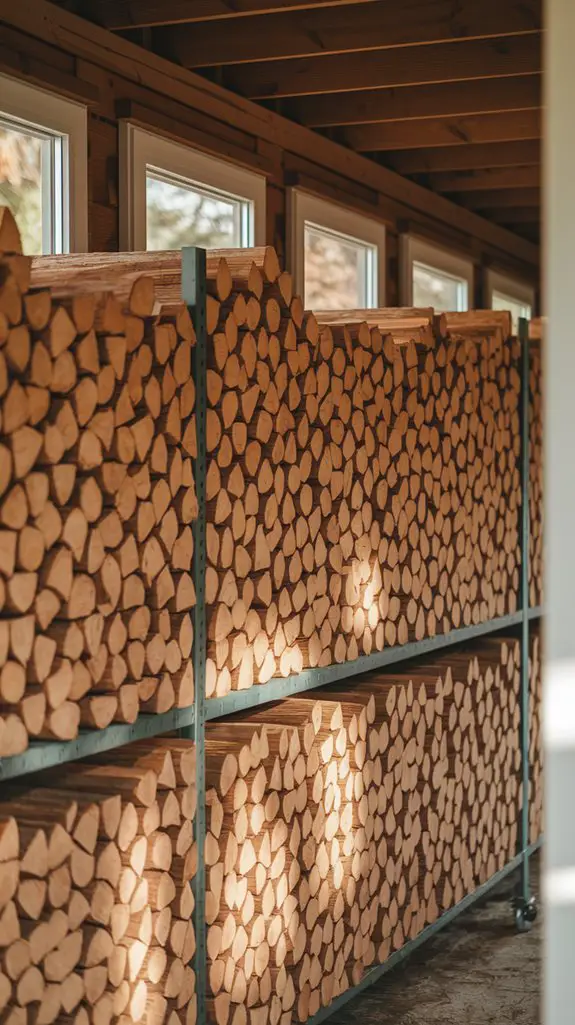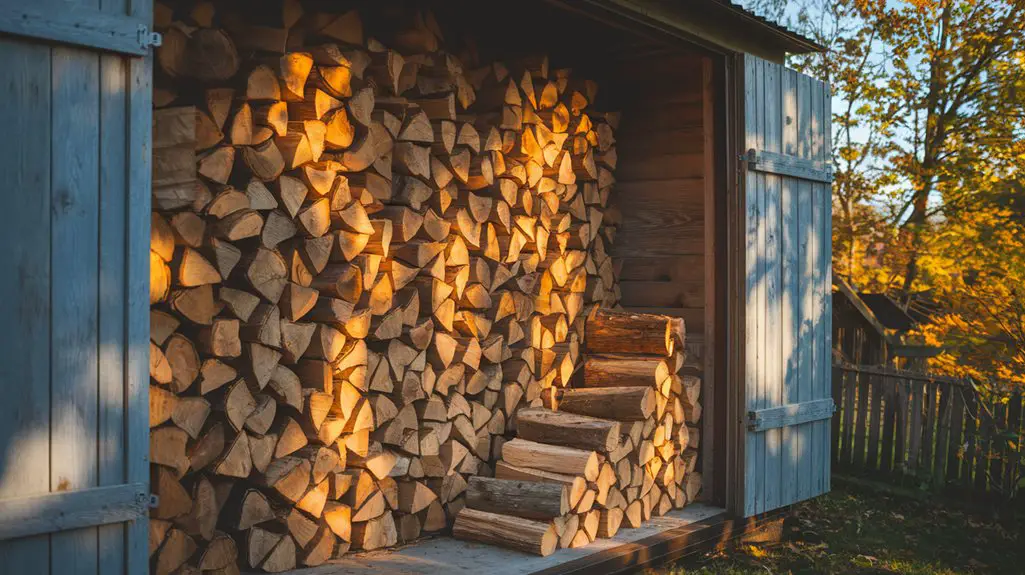You’ll discover that organizing firewood in your shed isn’t just about tidiness—it’s about maximizing your heating potential. When you properly stack and store your wood, you’re creating ideal conditions for seasoning, which reduces moisture content from 50% to under 20%. This transformation means your fires will ignite faster, burn hotter, and produce less smoke. What most homeowners don’t realize is how proper organization affects the very quality of their winter warmth.
The Benefits of Proper Firewood Organization for Seasoning and Efficiency
When you take the time to properly organize your firewood, you’re not just creating a tidy storage space—you’re actively enhancing the quality of your fuel and maximizing your heating efficiency.
Properly stacked wood allows air to circulate between logs, accelerating the seasoning process that reduces moisture content from 50% to the ideal 20%. This drier wood ignites faster, burns hotter, and produces notably less smoke.
Your organization system should elevate logs off the ground, preventing rot and deterring pests from making homes in your woodpile.
Arranging by size and age also lets you use older wood first, ensuring nothing goes to waste. As winter approaches, you’ll appreciate the practical benefits when you’re grabbing perfectly seasoned logs without digging through a disorganized pile in freezing temperatures. Additionally, consider utilizing creative firewood storage ideas to further optimize your backyard space.
Essential Storage Systems to Prevent Moisture and Pest Infestation

Protecting your firewood from moisture and pests requires specific storage systems that go beyond basic stacking. You’ll need to create a moisture barrier between your wood and the ground using pallets or specialized racks. This elevation prevents ground moisture from seeping upward while facilitating essential airflow.
For ideal protection, consider these proven storage systems:
| System Type | Moisture Protection | Pest Deterrence |
|---|---|---|
| Pallet Base | Elevates 4-6 inches | Reduces termites |
| Metal Racks | No water absorption | Deters woodborers |
| Covered Racks | Repels rain/snow | Prevents nesting |
Always maintain at least 6 inches of clearance between your woodpile and shed walls. This gap discourages rodents from using your stack as a highway into your structure. Installing mesh screens on ventilation points will further safeguard your supply while still allowing proper air circulation. Additionally, using stylish firewood storage containers can enhance the aesthetic of your landscape while keeping your firewood well-protected.
Maximizing Limited Shed Space for Year-Round Firewood Access

Even in the most compact shed spaces, strategic organization can transform a cramped storage area into an efficient firewood management system.
You’ll need to maximize vertical space while maintaining proper airflow for seasoning your logs properly.
- Install adjustable shelving along walls to create tiered storage that keeps different wood types separated and easily accessible.
- Utilize the often-overlooked ceiling space with hanging racks for kindling and smaller pieces.
- Implement a rotation system with clearly marked zones for “newly stacked,” “seasoning,” and “ready to burn” wood.
- Create narrow rolling carts that can slide between stationary stacks, allowing you to access wood from the back without dismantling your entire supply.
This approach guarantees you’ll have properly dried firewood regardless of season while maintaining a navigable pathway through your storage area. Moreover, incorporating functional firewood storage ideas can further enhance your outdoor cooking experience.
Creative Stacking Methods That Improve Airflow and Drying
The artistry of stacking firewood extends far beyond simple organization—it directly impacts how quickly and thoroughly your logs will dry.
Try the traditional Holz Hausen method, a circular stack with a domed top that channels air through its center while shedding rain effectively.
For rectangular spaces, the Shaker method creates a self-supporting structure where logs face alternating directions in each row, forming stable end pillars. This maximizes airflow around individual pieces.
Consider the criss-cross technique for smaller quantities, where perpendicular layers create ample ventilation channels.
Or experiment with the “log cabin” style, building hollow squares that expose maximum surface area to circulating air.
Always elevate your stacks 4-6 inches off the ground using pallets or pressure-treated lumber to prevent moisture wicking from below. Additionally, proper firewood storage methods can significantly enhance the overall efficiency of your wood-burning stove.
Combining Aesthetics and Functionality in Your Firewood Storage Design
A well-designed firewood storage solution serves as both a practical necessity and an attractive feature in your backyard landscape.
When combining aesthetics with functionality, you’re creating a storage system that you’ll be proud to showcase rather than hide.
Consider these design elements to elevate your firewood storage:
- Use complementary materials that match your home’s exterior, such as cedar slats or wrought iron frames that create visual harmony.
- Incorporate pitched roofs to protect wood while adding architectural interest to your storage structure.
- Position your stack strategically to create natural privacy screens or windbreaks in your yard.
- Add small lighting elements that highlight your woodpile at night, turning utilitarian storage into a landscape feature.
- Explore DIY firewood rack designs that enhance both the utility and beauty of your outdoor space.
The most successful designs embrace wood’s natural beauty while ensuring it remains accessible and properly ventilated.
Conclusion
Isn’t a well-organized firewood shed one of homesteading’s greatest satisfactions? By implementing proper stacking methods, moisture barriers, and strategic airflow systems, you’ll transform your humble shed into a powerhouse of heating efficiency. You’re not just storing wood—you’re curating a essential resource that’ll reward you with cleaner burns, significant fuel savings, and the comforting reliability of dry, accessible firewood throughout even the harshest winter months.




